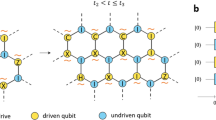Abstract
We design a nearest-neighbor architectural layout that uses fixed positive and negative couplings between qubits, to overcome the effects of relative phases due to qubit precessions, both during idle times and gate operations. The scheme uses decoherence-free subspaces, and we show how to realize gate operations on these encoded qubits. The main advantage of our scheme is that most gate operations are realized by only varying a single control parameter, which greatly reduces the circuit complexity. Moreover, the scheme is robust against phase errors occurring as a result of finite rise and fall times due to non-ideal pulses.
Similar content being viewed by others
Abbreviations
- LNN:
-
Linear nearest neighbor
- DFS:
-
Decoherence free subspace
- DD:
-
Dynamical decoupling
- CNOT:
-
Controlled-NOT
References
Nielson M.A., Chuang I.L.: Quantum Computation and Quantum Information. Cambridge University Press, Cambridge (2001)
Makhlin Y., Schon G., Shnirman A.: Josephson-junction qubits with controlled couplings. Nature 398, 305–309 (1999)
Cirac J.J., Zoller P.: A scalable quantum computer with ions in an array of microtraps. Nature 404, 579–581 (2000)
Grover L.K.: Quantum mechanics helps in searching for a needle in a haystack. Phys. Rev. Lett. 79, 325–328 (1997)
Duan L.-M., Guo G.-C.: Preserving coherence in quantum computation by pairing quantum bits. Phys. Rev. Lett. 79, 1953–1956 (1997)
Zanardi P., Rasetti M.: Error avoiding quantum codes. Mod. Phys. Lett. B 11, 1085–1093 (1997)
Lidar, D.A., Whaley, K.B.: Decoherence-free subspaces and subsystems. ArXiv:quant-ph/0301032 (2003)
Viola L., Lloyd S.: Dynamical suppression of decoherence in two-state quantum systems. Phys. Rev. A 58, 2733–2744 (1998)
Vitali D., Tombesi P.: Using parity kicks for decoherence control. Phys. Rev. A 59, 4178–4186 (1999)
Hahn E.L.: Spin echoes. Phys. Rev. 80, 580–594 (1950)
Viola L., Knill E., Lloyd S.: Dynamical decoupling of open quantum system. Phys. Rev. Lett. 82, 2417–2421 (1999)
Facchi P., Lidar D.A., Pascazio P.: Unification of dynamical decoupling and the quantum zeno effect. Phys. Rev. A 69, 032314–032317 (2004)
Viola L., Knill E.: Robust dynamical decoupling of quantum systems with bounded controls. Phys. Rev. Lett. 90, 037901–037904 (2003)
Viola L., Knill E.: Random decoupling schemes for quantum dynamical control and error suppression. Phys. Rev. Lett. 94, 060502–060505 (2005)
Biercuk M.J., Uys H., VanDevender A.P., Shiga N., Itano W.M., Bollinger J.J.: Optimized dynamical decoupling in a model quantum memory. Nature 458, 996–1000 (2009)
Beavan S.E., Fraval E., Sellars M.J.: Demonstration of the reduction of decoherent errors in a solid-state qubit using dynamical decoupling techniques. Phys. Rev. A 80, 032308–032316 (2009)
Damodarakurup S., Lucamarini M., Di Giuseppe G., Vitali D., Tombesi P.: Optimized noise filtration through dynamical decoupling. Phys. Rev. Lett. 103, 040501–040504 (2009)
Sagi Y., Almog I., Davidson N.: Process tomography of dynamic decoupling in a dense cold atomic ensemble. Phys. Rev. Lett. 105, 053201–053204 (2010)
Petta J.R., Johnson A.C., Taylor J.M., Laird E.A., Yacoby A., Lukin M.D., Marcus C.M., Hansen M.P., Gossard A.C.: Coherent manipulation of coupled electron spins in semiconductor quantum dots. Science 309, 2180–2184 (2005)
Harris R., Berkley A.J., Johnson M.W., Bunyk P., Govorkov S., Thom M.C., Uchaikin S., Wilson A.B., Chung J., Holtham E., Biamonte J.D., Smirnov A.Yu., Amin M.H.S., van den Brink A.M.: Sign- and magnitude-tunable coupler for superconducting flux qubits. Phys. Rev. Lett. 98, 177001–177004 (2007)
Groszkowski P., Fowler A.G., Motzoi f., Wilhelm F.K.: Tunable coupling between three qubits as a building block for a superconducting quantum computer. Phys. Rev. B 84, 144516–144522 (2011)
Zhou X., Zhou Z., Guo G., Feldman M.J.: Quantum computing with un-tunable couplings. Phys. Rev. Lett. 89, 197903–197906 (2002)
Benjamin S.C., Bose S.: Quantum computing with an ‘always-on’ Heisenberg interaction. Phys. Rev. Lett. 90, 247901–247904 (2003)
Fowler A.G., Thompson W.F., Yan Z.: Long-range coupling and scalable architecture for superconducting flux qubits. Phys. Rev. B 76, 174507–174513 (2007)
Zhang J., Whaley K.B.: Generation of quantum logic operations from physical Hamiltonians. Phys. Rev. A 71, 052317–052329 (2005)
Berman G.P., Doolen G.D., Holm G.D., Tsifrinovich V.I.: Quantum computing on a class of one-dimensional Ising systems. Phys. Lett. A 193, 444–450 (1999)
Burkard G., Loss D., DiVincenzo D.P.: Coupled quantum dots as quantum gates. Phys. Rev. B 59, 2070–2078 (1999)
Yamamoto T., Pashkin Y.A., Astafiev O., Nakamura Y., Tsai J.S.: Demonstration of conditional gate operation using superconducting charge qubits. Nature 425, 941–944 (2003)
Lantz, J., Wallquist, M., Shumeiko, V.S., Wendin, G.: Josephson junction qubit network with current-controlled interaction. Phys. Rev. B 70, 140507–140510 (R) (2004)
Kumar P., Skinner S.R.: Universal quantum computing in linear nearest neighbor architectures. Quantum Inf. Comput. 11, 0300–0312 (2011)
Fedorov A., Macha P., Feofanov A.K., Harmans C.J.P.M., Mooij J.E.: Tuned transition from quantum to classical for macroscopic quantum states. Phys. Rev. Lett. 106, 170404–170407 (2011)
Orlando T.P., Mooij J.E., Tian L., van der Wal C., Levitov L.S., Lloyd S., Mazo J.J.: Superconducting persistent-current qubit. Phys. Rev. B 60, 15398–15413 (1999)
Ferber J., Wilhelm M.: Efficient creation of multi-partite entanglement in flux qubits. Nanotechnology 21, 274015 (2010)
Serban I., Solano E., Wilhelm F.K.: Phase-theory for dispersive detectors of superconducting qubits. Phys. Rev. B 76, 104510–104516 (2007)
Author information
Authors and Affiliations
Corresponding author
Rights and permissions
About this article
Cite this article
Kumar, P., Skinner, S.R. & Daraeizadeh, S. A nearest neighbor architecture to overcome dephasing. Quantum Inf Process 12, 157–188 (2013). https://doi.org/10.1007/s11128-012-0365-z
Received:
Accepted:
Published:
Issue Date:
DOI: https://doi.org/10.1007/s11128-012-0365-z




